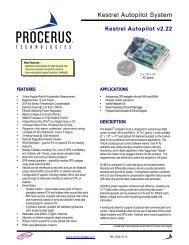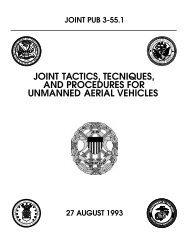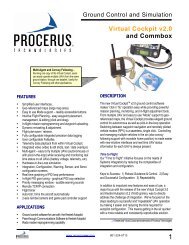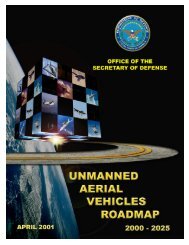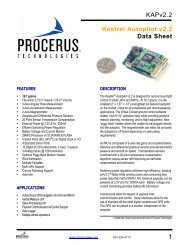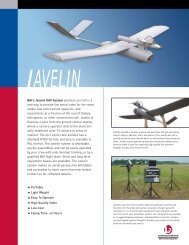Executive Summary - NASA
Executive Summary - NASA
Executive Summary - NASA
- No tags were found...
You also want an ePaper? Increase the reach of your titles
YUMPU automatically turns print PDFs into web optimized ePapers that Google loves.
UAV Roadmap 2002<strong>Executive</strong> <strong>Summary</strong>This document presents the Department of Defense’s (DoD) Roadmap fordeveloping and employing Unmanned Aerial Vehicles (UAVs) and Unmanned CombatAir Vehicles (UCAVs) over the next 25 years (2002 to 2027). DoD’s operational UAVsystems include Predator, Hunter, Shadow, and Pioneer which have demonstratedtremendous capability in recent military operations. Developmental systems such asGlobal Hawk and many small UAV systems have also been put to the test in recentcombat and combat support operations. Taken as a whole, this technology area offersprofound opportunities to transform the manner in which this country conducts a widearray of military and military support operations. As with any new technology, there isnaturally some reluctance to transition to a radically new capability. The need to fullydemonstrate UAVs in combat and realistic training environments is critical to themigration of this technology.The overarching goal of this roadmap, in concert with the Defense PlanningGuidance (DPG), is to define clear direction to the Services and Departments for alogical, systematic migration of mission capabilities to a new class of military tools. Thegoal is to address the most urgent mission needs that are supported both technologicallyand operationally by various UAV systems. Some missions can be supported by thecurrent state of the art in unmanned technology where the capabilities of current or neartermDoD assets are sufficient and the risk to DoD members is relative low. Othermission areas, however, are in desperate need of additional capability and present highrisk to aircraft crews. These mission areas, highlighted in this roadmap, will receivesignificant near-term effort by the Department.This Roadmap describes the Services’ ongoing UAV efforts (Section 2) andidentifies the capabilities needed by theater commanders to which UAVs could beapplied (Section 3), then couples them to emerging technologies (Section 4) andoperational concepts (Section 5) that could enable these capabilities within the Services’programs. The resulting Roadmap (Section 6) links capability-enhancing technologies tothe life cycles of current and projected UAV programs. It is a map of opportunities, notpoint designs - a description of the future potential of UAVs.This Roadmap also provides a current snapshot of the status of the Department’snumerous unmanned aviation efforts. Having accurate “ground truth” on DoD’s variousUAV programs and research efforts does not solve problems, but it does allow theDepartment to place emphasis in appropriate areas. One such area is standards, theframework of common requirements necessary to ensure forward/backward compatibilitywithin systems and interoperability among them. The Office of the Secretary of Defense(OSD), as part of its oversight responsibilities for Defense-wide acquisition andtechnology, intends this Roadmap to be directive in such cross-program areas asstandards development and other interoperability solutions.The U.S. military has a long and continuous history of involvement with UAVs,stretching back to 1917. UAVs had active roles in the Vietnam, Persian Gulf, andBalkans conflicts, as well as Afghan operations, providing critical reconnaissance ineach. With recent technology improvements allowing more capability per pound, today’sUAVs are more sophisticated and capable than ever. As the military’s operational tempohas increased, so too has the employment of UAVs, to include performing a wider varietyiii



